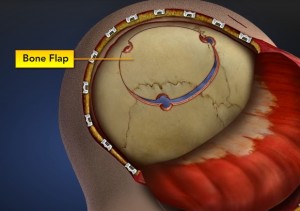Craniotomy – Craniectomy Essential Brain Surgery
Removing Part of Skull in a Craniotomy
By Gordon S. Johnson, Jr.
A craniotomy or a craniectomy both involve the removal of a bone flap (a substantial piece of the skull) to give the neurosurgeon access the emergent pathology inside the brain. The difference between a craniotomy and a craniectomy is that in a craniotomy the bone flap is replaced in the skull at the end of the surgery. In a craniectomy, the bone flap is not reinserted before the completion of surgery. The craniectomy is usually chosen in order to allow the brain more room for the swelling. A craniectomy can reduce ICP.

As shown, in a Craniotomy, the neurosurgeon removes a piece of the skull, the bone flap, in order to perform surgery inside the brain to relieve ICP.
In a craniectomy, the bone flap may be stored in a freezer until the brain has recovered. Then an additional surgery is done to return the bone flap to the skull. If the bone flap isn’t reused, plates or artificial bone may be needed to finish the reconstruction of the skull. In many cases there will be a less than complete fusion of the skull after the the second surgery, resulting in defects in the skull.
How much of the skull which needs to be removed depends upon the type of surgery being performed.
Complications from a craniotomy and a craniectomy may include seizures. For this reason, anti-seizure medications are given for seven days after a craniotomy and a craniectomy. Bacterial meningitis can also be a complication. Pain is a factor in craniotomy patients, particularly to the scalp because of the surgical wound. This can be managed through the use of scalp infiltrations, nerve scalp blocks, and morphine.